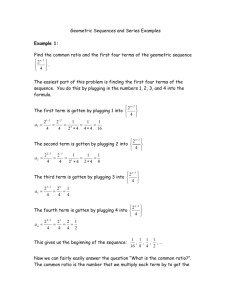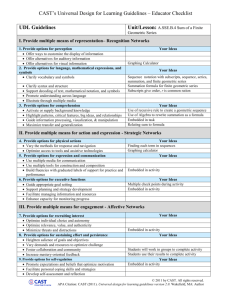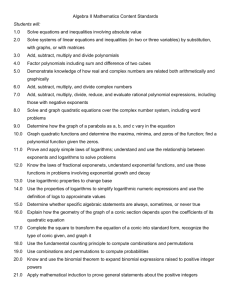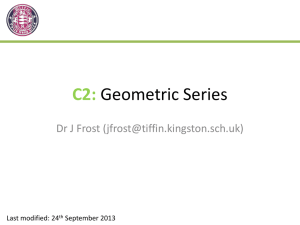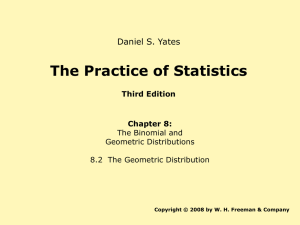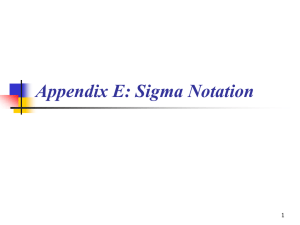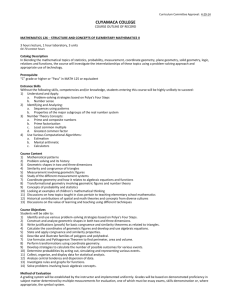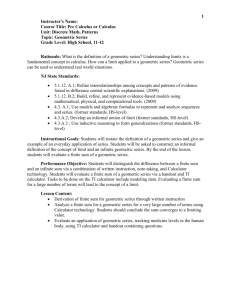A.SSE.B.4 Lesson Sum of a Finite Geometric Series
advertisement
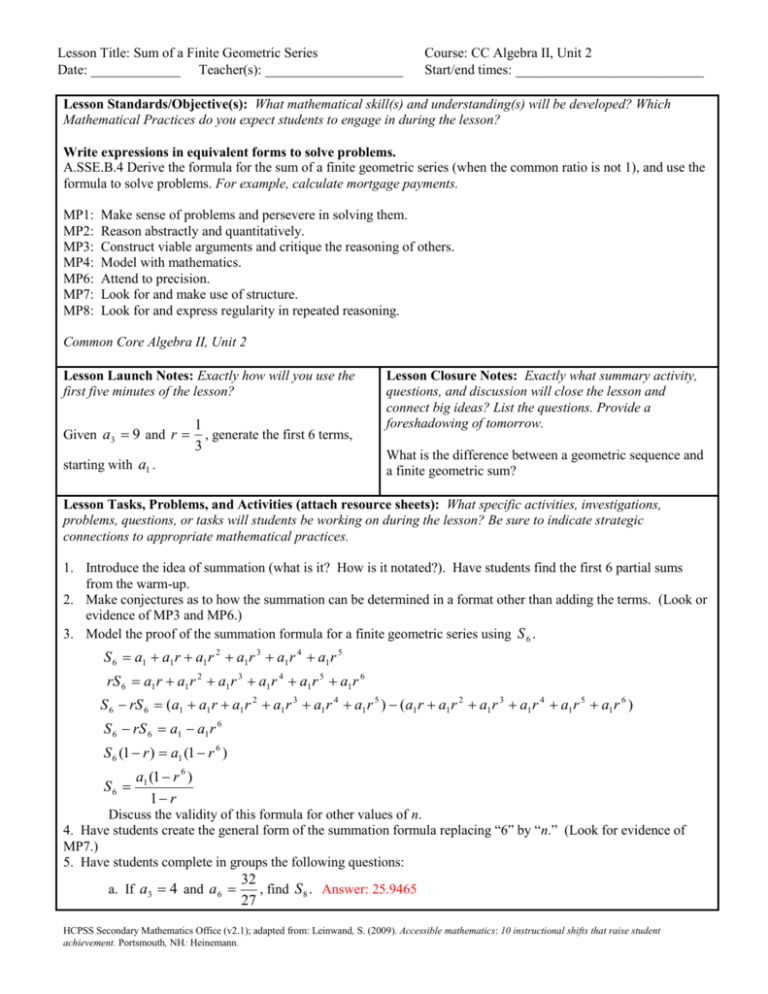
Lesson Title: Sum of a Finite Geometric Series Date: _____________ Teacher(s): ____________________ Course: CC Algebra II, Unit 2 Start/end times: _________________________ Lesson Standards/Objective(s): What mathematical skill(s) and understanding(s) will be developed? Which Mathematical Practices do you expect students to engage in during the lesson? Write expressions in equivalent forms to solve problems. A.SSE.B.4 Derive the formula for the sum of a finite geometric series (when the common ratio is not 1), and use the formula to solve problems. For example, calculate mortgage payments. MP1: MP2: MP3: MP4: MP6: MP7: MP8: Make sense of problems and persevere in solving them. Reason abstractly and quantitatively. Construct viable arguments and critique the reasoning of others. Model with mathematics. Attend to precision. Look for and make use of structure. Look for and express regularity in repeated reasoning. Common Core Algebra II, Unit 2 Lesson Launch Notes: Exactly how will you use the first five minutes of the lesson? Given a3 9 and r 1 , generate the first 6 terms, 3 starting with a1 . Lesson Closure Notes: Exactly what summary activity, questions, and discussion will close the lesson and connect big ideas? List the questions. Provide a foreshadowing of tomorrow. What is the difference between a geometric sequence and a finite geometric sum? Lesson Tasks, Problems, and Activities (attach resource sheets): What specific activities, investigations, problems, questions, or tasks will students be working on during the lesson? Be sure to indicate strategic connections to appropriate mathematical practices. 1. Introduce the idea of summation (what is it? How is it notated?). Have students find the first 6 partial sums from the warm-up. 2. Make conjectures as to how the summation can be determined in a format other than adding the terms. (Look or evidence of MP3 and MP6.) 3. Model the proof of the summation formula for a finite geometric series using S 6 . S 6 a1 a1 r a1 r 2 a1 r 3 a1 r 4 a1 r 5 rS 6 a1 r a1 r 2 a1 r 3 a1 r 4 a1 r 5 a1 r 6 S 6 rS 6 (a1 a1 r a1 r 2 a1 r 3 a1 r 4 a1 r 5 ) (a1 r a1 r 2 a1 r 3 a1 r 4 a1 r 5 a1 r 6 ) S 6 rS 6 a1 a1 r 6 S 6 (1 r ) a1 (1 r 6 ) S6 a1 (1 r 6 ) 1 r Discuss the validity of this formula for other values of n. 4. Have students create the general form of the summation formula replacing “6” by “n.” (Look for evidence of MP7.) 5. Have students complete in groups the following questions: a. If a3 4 and a 6 32 , find S 8 . Answer: 25.9465 27 HCPSS Secondary Mathematics Office (v2.1); adapted from: Leinwand, S. (2009). Accessible mathematics: 10 instructional shifts that raise student achievement. Portsmouth, NH: Heinemann. Lesson Title: Sum of a Finite Geometric Series Date: _____________ Teacher(s): ____________________ b. If a 5 Course: CC Algebra II, Unit 2 Start/end times: _________________________ 32 2 and r , find S10 . Answer: 416.62297 5 5 c. A ball is dropped from a height of 16 feet. The ball bounces to 40% of its previous height with each bounce. How high did the ball bounce on the 8th bounce? What is the sum of the heights of the first eight bounces? Answer: On the eighth bounce, the ball reached .03 feet. Together, the heights of the first eight bounces totaled to 26.62 feet. d. Use the geometric series formula to calculate the sum of the first 5 terms of the following geometric sequences. 0.3, -0.9, 2.7, -8.1, 24.3, … Answer: a1 0.3 , r 3 0.3(1 (3) 4 ) 1 (3) S 5 6 S5 Evidence of Success: What exactly do I expect students to be able to do by the end of the lesson, and how will I measure student success? That is, deliberate consideration of what performances will convince you (and any outside observer) that your students have developed a deepened and conceptual understanding. Students are expected to follow the proof of finite geometric series and use the formula appropriately. Students are expected to recall how to generate geometric sequences. Notes and Nuances: Vocabulary, connections, anticipated misconceptions (and how they will be addressed), etc. Vocabulary: geometric sequence vs. series, summation Connections: Students will connect to finding a n in a geometric sequence based on a variety of entry points (given information). Anticipated misconceptions: Students not following the proof, students misplacing the exponent in the numerator on the quantity (1-r) instead of just on r, using the calculator incorrectly (parenthesis issues). Some students may still struggle finding a geometric sequence. Resources: What materials or resources are essential for students to successfully complete the lesson tasks or activities? Homework: Exactly what follow-up homework tasks, problems, and/or exercises will be assigned upon the completion of the lesson? Paper, pencil, calculator To be determined by teacher. Lesson Reflections: How do you know that you were effective? What questions, connected to the lesson standards/objectives and evidence of success, will you use to reflect on the effectiveness of this lesson? Were students able to follow the proof of a finite geometric series? Were students able to recall how to generate geometric sequences? Were students able to apply the summation formula correctly in the practice problems? Were students able to use the calculator correctly to help them find the sum? Howard County Public Schools Office of Secondary Mathematics Curricular Projects has licensed this product under a Creative Commons Attribution-NonCommercial-NoDerivs 3.0 Unported License. HCPSS Secondary Mathematics Office (v2.1); adapted from: Leinwand, S. (2009). Accessible mathematics: 10 instructional shifts that raise student achievement. Portsmouth, NH: Heinemann.


